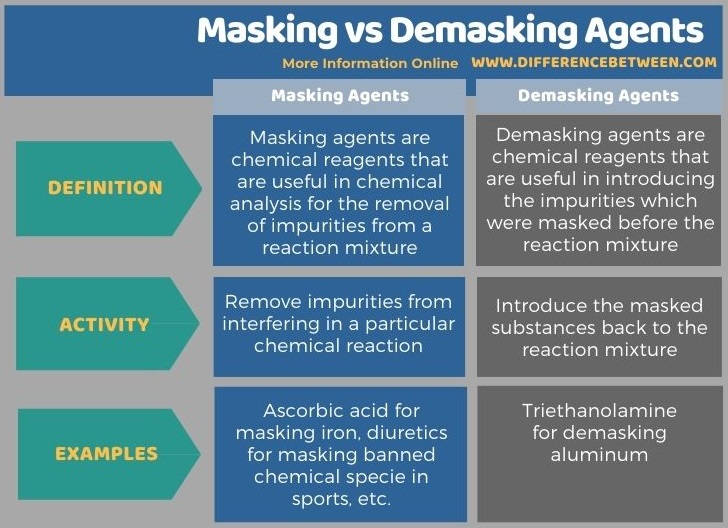Difference Between Masking and Demasking Agents
Table of Contents
The key difference between masking and demasking agents is that masking agents are useful in chelating any interferences coming from chemical species during an analysis, whereas demasking agents are useful in releasing the interferences that were masked before.
Masking and demasking agents are important in chemical analysis techniques for the removal and introduction of impurities from and to the reaction mixture.
CONTENTS
1. Overview and Key Difference
2. What are Masking Agents
3. What are Demasking Agents
4. Side by Side Comparison – Masking vs Demasking Agents in Tabular Form
5. Summary
What are Masking Agents?
Masking agents are chemical reagents that are useful in chemical analysis for the removal of impurities from a reaction mixture. In the field of sports, a masking agent is important in hiding or preventing the detection of a banned substance or an illegal drug such as an anabolic steroid or a stimulant. A simple form of a masking agent that we can use in this masking process is diuretic compounds. It works by enhancing water loss through urine excretion and thereby diluting the urine. This results in a low concentration of the banned substance because most of the substance is excreted from the body in a dilute form, which makes it very difficult for laboratories to detect the substance.

Figure 01: Activity of Diuretics
Chelation is a type of masking process in analytical and inorganic chemistry fields. It occurs through the bonding of ions and molecules to metal ions and masking the metal ion to avoid it from participating in any desired chemical reaction in the reaction mixture. In this context, we name the masking agents as chelating agents. Some common chelating agents include arsenic chelators, copper chelators, ion chelators, etc. The chelation reactions are very important in applications such as providing nutritional supplements, in chelation therapy, etc.
What are Demasking Agents?
Demasking agents are chemical reagents that are useful in introducing the impurities which were masked before the reaction mixture. During the demasking process, the masked substance regains its ability to enter into the desired chemical reaction. In chemical reactions such as complexometric titrations, demasking reagents are used to regain the ability of masked ions to enter the reaction with indicator and EDTA. For example, for the selective demasking of aluminum, we can use triethanolamine as a demasking agent. We can use this demasking agent in a reaction where we used ascorbic acid as a masking agent in order to avoid any interference from iron.
What is the Difference Between Masking and Demasking Agents?
Masking agents are chemical reagents that are useful in chemical analysis for the removal of impurities from a reaction mixture. Demasking agents are chemical reagents that are useful in introducing the impurities which were masked before the reaction mixture. Therefore, the key difference between masking and demasking agents is that masking agents are useful in chelating any interferences coming from chemical species during an analysis, whereas demasking agents are useful in releasing the interferences that are masked before. In other words, masking agents remove impurities from interfering with a particular chemical reaction while demasking agents introduce the masked substances back to the reaction mixture.
Below is a summary of the difference between masking and demasking agents in tabular form.

Summary – Masking vs Demasking Agents
Masking and demasking agents are important in chemical analysis reactions. The key difference between masking and demasking agents is that masking agents are useful in chelating any interferences coming from chemical species during an analysis, whereas demasking agents are useful in releasing the interferences that are masked before.
Reference:
1. Aziz, Rabia. Complexometric Titration. 23 Feb. 2017, Available here.
Image Courtesy:
1. “K-sparing diuretics” By Pharmattila – Own work (CC BY-SA 4.0) via Commons Wikimedia
ncG1vNJzZmivp6x7pbXFn5yrnZ6YsqOx07CcnqZemLyue8OinZ%2Bdopq7pLGMm5ytr5Wau265wKyioqaXYq6vsIydnKaZo6C2r7OMmp6epqSofA%3D%3D